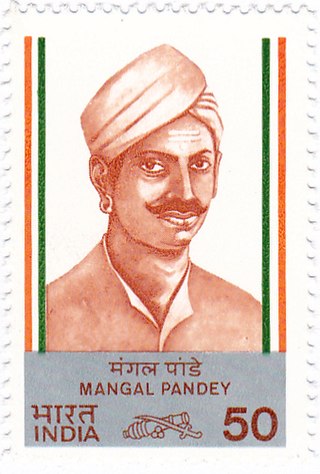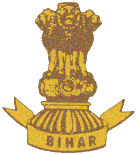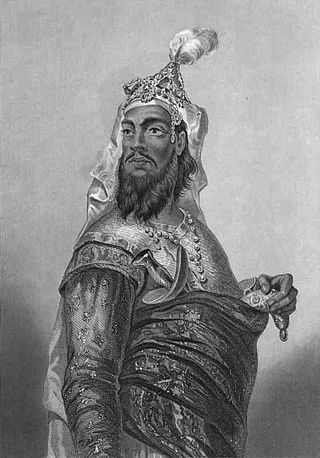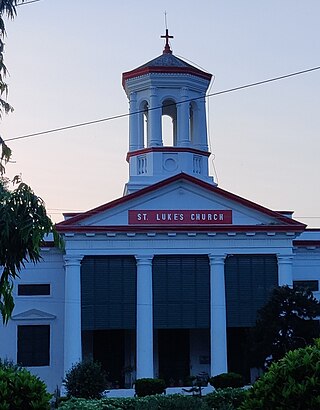
The Indian Rebellion of 1857 was a major uprising in India in 1857–58 against the rule of the British East India Company, which functioned as a sovereign power on behalf of the British Crown. The rebellion began on 10 May 1857 in the form of a mutiny of sepoys of the Company's army in the garrison town of Meerut, 40 mi (64 km) northeast of Delhi. It then erupted into other mutinies and civilian rebellions chiefly in the upper Gangetic plain and central India, though incidents of revolt also occurred farther north and east. The rebellion posed a military threat to British power in that region, and was contained only with the rebels' defeat in Gwalior on 20 June 1858. On 1 November 1858, the British granted amnesty to all rebels not involved in murder, though they did not declare the hostilities to have formally ended until 8 July 1859.
Events in the year 1857 in India.

Mangal Pandey was an Indian soldier who played a key role in the events taking place just before the outbreak of the Indian rebellion of 1857. He was a sepoy (infantryman) in the 34th Bengal Native Infantry (BNI) regiment of the British East India Company. In 1984, the Indian government issued a postage stamp to remember him. His life and actions have also been portrayed in several cinematic productions.

Arrah is a city and a municipal corporation in Bhojpur district in the Indian state of Bihar. It is the headquarters of Bhojpur district, located near the confluence of the Ganges and Sone rivers, some 24 mi (39 km) from Danapur and 36 mi (58 km) from Patna.

Danapur is an Indian satellite town and one of the 6 sub-divisions (Tehsil) in Patna district of Bihar state. The population was 182,241 at the 2011 India Census. It is part of the Patna Metropolitan Region. It was constituted as a municipality in 1887. Danapur is also a shelter and hatchery for the migrating Siberian cranes, locally called Janhgil. They visit every year during the monsoon season for breeding and leave this place before the start of the winter season. The Sub-Area Headquarters of Bihar and Jharkhand is situated in the army cantonment here.

The Battle of Buxar was fought between 22 and 23 October 1764, between the forces under the command of the British East India Company, led by Hector Munro, and the combined armies of Balwant Singh, Raja of Benaras; Mir Qasim, Nawab of Bengal till 1764; the Nawab of Awadh, Shuja-ud-Daula; and the Mughal Emperor, Shah Alam II. The battle was fought at Buxar, a "strong fortified town" within the territory of Bihar, located on the banks of the Gangas river about 130 kilometres (81 mi) west of Patna; it was a challenging victory for the British East India Company. The war was brought to an end by the Treaty of Allahabad in 1765. The defeated Indian rulers were forced to sign this treaty, granting the East India Company diwani rights, which allowed them to collect revenue from the territories of Bengal, Bihar, and Orissa on behalf of the Mughal emperor. This gave the company immense economic control, enabling them to pass financial policies to exploit the resources of the region for their own benefit.

Shaikh Paltu was a soldier (sepoy) with the British East India Company who served in the 34th Bengal Native Infantry in March 1857, shortly before widespread discontent broke out in the Bengal Army. When on March 29, Sepoy Mangal Pandey of the same regiment attacked a British lieutenant, Shaikh Paltu intervened to assist the officer and seized Mangal Pandey. The sepoys of the quarter guard on duty and others present refused to take any action against their comrade and remained as "idle spectators of a murderous assault".
Barrackpur Cantonment is a Town and a cantonment board of North 24 Parganas district in the Indian state of West Bengal. It also a part of the area covered by Kolkata Metropolitan Development Authority (KMDA).
Koilwar is a nagar panchayat town and corresponding community development block in Bhojpur district in the Indian state of Bihar. As of 2011, the population of Koilwar town was 17,725, in 2,893 households. It lies on the Arrah-Patna railway route. It is one of the 14 blocks under Bhojpur district.

The Bihar Regiment is an Indian Army infantry regiment. It traces its origins back to the British Indian Army. The Bihar Regiment was formed in 1941 by regularising the 11th (Territorial) Battalion, the 19th Hyderabad Regiment, and raising new battalions. The Bihar Regimental Centre (BRC) is located at Danapur Cantonment, Patna, the second oldest cantonment of India. INS Vikramaditya, the Indian Navy's largest ship and one of its two aircraft carriers is affiliated to the Bihar Regiment, Indian Army's highly decorated and battle-hardened unit.

The Bengal Army was the army of the Bengal Presidency, one of the three presidencies of British India within the British Empire.

The regiments of Bengal Native Infantry, alongside the regiments of Bengal European Infantry, were the regular infantry components of the East India Company's Bengal Army from the raising of the first Native battalion in 1757 to the passing into law of the Government of India Act 1858. At this latter point control of the East India Company's Bengal Presidency passed to the British Government. The first locally recruited battalion was raised by the East India Company in 1757 and by the start of 1857 there were 74 regiments of Bengal Native Infantry in the Bengal Army. Following the Mutiny the Presidency armies came under the direct control of the United Kingdom Government and there was a widespread reorganisation of the Bengal Army that saw the Bengal Native Infantry regiments reduced to 45.

Kunwar Singh, also known as Babu Kunwar Singh, was a leader and military commander during the Indian Rebellion of 1857. He led a selected band of armed soldiers against the troops under the command of the British East India Company. He was the chief organiser of the fight against the British in Bihar.
The 5th Light Infantry was an infantry regiment of the Bengal Army and later of the raj-period British Indian Army. It could trace its lineage back to 1803, when it was raised as the 2nd Battalion, 21st Bengal Native Infantry. The regiment was known by a number of different names: the 42nd Bengal Native Infantry 1824–1842, the 42nd Bengal Native (Light) Infantry 1842–1861, the 5th Bengal Native (Light) Infantry 1861–1885 and the 5th Bengal (Light) Infantry 1885–1903. Its final designation 5th Light Infantry was a result of the Kitchener Reforms of the Indian Army, when all the old presidency titles (Bengal) were removed. During World War I the regiment was stationed in Singapore and became notorious for its involvement in the 1915 Singapore Mutiny. The regiment was disbanded in 1922, after another set of reforms of the post World War I Indian Army.

The 45th Rattray's Sikhs was an infantry regiment of the British Indian Army. They could trace their origins to the 1st Bengal Military Police Battalion raised in April 1856, at Lahore, by Captain Thomas Rattray originally consisting of a troop of 100 cavalry and 500 infantry. The initial class composition of the troops was 50% Sikhs and 50% Dogras, Rajputs and Mussulmans (Muslims) from the Punjab and the North-West Frontier. It is said that he went through the villages challenging men to wrestle with him on the condition that they had to join up. Whatever the case, the regiment was raised and trained and developed as an elite corps, which soon saw action in Bihar in the Sonthal 'parganas'. After sterling service in Bihar, Bengal and Assam, and during the 1857 Mutiny, the cavalry portion was eventually disbanded in 1864 and the infantry section was taken into the line of Bengal Native Infantry as the '45th Native Regiment of Infantry'.

Bailey Road is a road and neighbourhood in Patna, India. It connects Patna with Danapur. It roughly starts from Income Tax Golambar and ends in Danapur, running through the heart of the city. It is one of the most important roads in the city. Many important landmarks like Patna High Court, Patna Women's College, Patna Secretariat, Patna Zoo, Patna Airport, Bihar Museum etc. are situated beside or near to this road. Bailey Road was officially renamed as Jawahar Lal Nehru Marg, but this road is still widely known as Bailey Road. Now, this road has been renamed as Nehru Path by the government of Bihar. This area is served by Shastrinagar Police Station of Patna Police.

The siege of Arrah took place during the Indian Mutiny. It was the eight-day defence of a fortified outbuilding, occupied by a combination of 18 civilians and 50 members of the Bengal Military Police Battalion, against 2,500 to 3,000 mutinying Bengal Native Infantry sepoys from three regiments and an estimated 8,000 men from irregular forces commanded by Kunwar Singh, the local zamindar or chieftain who controlled the Jagdishpur estate.
During the Indian Rebellion of 1857 a column of troops led by the commander of the 24th Regiment of Foot was sent to disarm Bengal Native Infantry units believed to be at risk of mutiny in Rawalpindi and Jhelum. At Rawalpindi, the 58th Bengal Native Infantry was disarmed peacefully, however the two companies of the 14th Bengal Native Infantry resisted the attempt by force of arms. These two companies were quickly defeated by the British, loyal native troops and the local population. In Jhelum, also garrisoned by the 14th, the concurrently timed disarmament was much more violent. Thirty five British soldiers of the 24th Regiment of Foot were killed along with a number of Loyal Indian troops, by mutinous sepoys of the 14th Bengal Native Infantry. When the mutineers realised that they, except the Sikhs, were to be disarmed, they mutinied and made a vigorous defence against the force that had arrived from Rawalpindi to disarm them. The following night a significant number of mutineers managed to slip away but most were subsequently arrested by the Kashmir authorities, into whose territory they had escaped.

St. Lukes Church is located at Danapur Cantonment in Danapur, a satellite town of Patna in the Indian state of Bihar. It is around 10 kilometers from Jay Prakash Narayan Airport. It is more than 200 years old, and has stood on the site through the most turbulent times in Indian history.

The Monghyr Mutiny occurred among European officers of the East India Company stationed in Bengal in 1766. The mutiny arose after the East India Company's governor of Bengal, Robert Clive, implemented an order to reduce the batta field allowance paid to its army officers. The batta had been doubled while the troops were in the service of the Nawab of Bengal Mir Jafar. Clive's order came into effect on 1 January 1766 and brought the allowances into line with those paid by the company in the rest of India. At this time the company army in Bengal was divided into three brigades under the command of Sir Robert Fletcher, Richard Smith and Robert Barker.



















